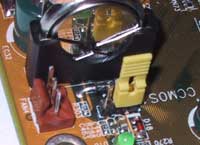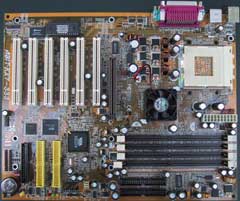VIA KT333 Motherboard Roundup - June 2002
by Anand Lal Shimpi on June 13, 2002 5:41 AM EST- Posted in
- Motherboards
ABIT KX7-333
|
Motherboard Specifications |
|
|
CPU
Interface
|
Socket-462
|
|
Chipset
|
VIA
KT333 North Bridge
VIA VT8233A South Bridge |
|
Bus
Speeds
|
100
- 250MHz (in 1MHz increments)
|
|
Core
Voltages Supported
|
1.100V
- 1.850V (in 0.025V increments)
|
|
I/O
Voltages Supported
|
3.5V/3.65V
|
|
DRAM
Voltages Supported
|
2.55V/2.65V/2.75V/2.85V
|
|
Memory
Slots
|
4
184-pin DDR DIMM Slots
|
|
Expansion
Slots
|
1
AGP Slot
6 PCI Slots |
|
Onboard
RAID
|
HighPoint
HPT372
|
|
Onboard
USB 2.0/IEEE-1394
|
N/A
|
|
Onboard
LAN
|
N/A
|
|
Onboard
Audio
|
N/A
|
ABIT has always been a favorite among the enthusiast crowd since their boards are often targeted solely at that market. A number of manufacturers such as ECS and Gigabyte historically focus on the OEM-only market and have thus been able to attain some very serious shipping volumes, but not ABIT. ABIT has almost always been enthusiast-centric and only a couple of years ago decided to really pursue the OEM market at all.
The KX7-333 is one of two KT333 based motherboards from ABIT; the board is clearly enthusiast targeted as it neither features CNR slots nor on-board audio header. The lack of any on-board audio header seems to be more of an image thing rather than a cost saving instrument as it doesn't give the KX7-333 that big of a price advantage; the lack of any on-board audio plays perfectly into the misconception that on-board audio requires more CPU time than add-in cards.
The board features six PCI slots and a single AGP 4X slot for expansion, which is necessary because the board is pretty bare from an integration level (e.g. no on-board Ethernet or audio).
The KX7-333 does have four DIMM slots, but stability with all four banks populated isn't guaranteed. In fact, we could only run the board reliably with two memory banks populated at DDR333 speeds with the timings set to automatically adjust according to the modules' SPD logic. In some cases, we could get three modules to work relatively well but overall you shouldn't count on using more than two sticks of memory in the KX7-333 without sacrificing stability.

ABIT's long time partner HighPoint is present on the board as usual with their HPT372 Ultra ATA 133 RAID controller. The controller drives the two yellow IDE ports on the motherboard with support for IDE RAID 0, 1, and 0+1. The chip supports stripe sizes from 64KB up to 2MB, which is much more flexible than the competing solution from Promise which makes it the ideal choice for motherboard manufacturers.

As a convenience feature, the KX7-333 uses a longer jumper with a little handle on the clear CMOS jumper pins to make resetting the CMOS much easier. The board also ships with two extra USB 1.1 headers that occupy a slot cutout in the back of your case.
According to ABIT the latest KX7-333 BIOS supports the Thoroughbred core; however, the board cannot read from the processor's on-die thermal diode. Because of this, no good thermal protection is built into the motherboard, which is a bit of a disappointment considering that the board was released long after Tom's Hardware Guide brought attention to the issue of thermal emergencies and the Athlon XP processor. To be fair to ABIT, most motherboard manufacturers still have yet to implement this functionality; it won't be until their KT400 boards ship before we see the ability to read directly from the processor's thermal diode.
The biggest attraction the KX7-333 can offer is ABIT's SoftMenu III BIOS setup and its associated overclocking features. Every single configuration option is offered in the BIOS including 1MHz FSB increments, Core/AGP/DDR voltage adjustment and of course, multiplier control. The KX7-333 was also able to attain the highest FSB possible out of the entire group of KT333 boards (ABIT's AT7 actually hit the same mark too).
With no more than two DIMMs installed in the test bed we did not encounter any stability issues with the board.











0 Comments
View All Comments